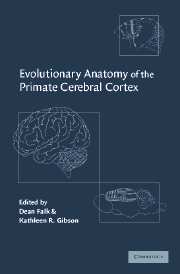Book contents
- Frontmatter
- Contents
- List of contributors
- Preface
- Prologue: Size matters and function counts
- Part I The evolution of brain size
- Introduction to Part I
- 1 Encephalization and its developmental structure: how many ways can a brain get big?
- 2 Neocortical expansion and elaboration during primate evolution: a view from neuroembryology
- 3 In defense of the Expensive Tissue Hypothesis
- 4 Bigger is better: primate brain size in relationship to cognition
- 5 The evolution of sex differences in primate brains
- 6 Brain evolution in hominids: are we at the end of the road?
- Part II Neurological substrates of species-specific adaptations
- Epilogue: The study of primate brain evolution: where do we go from here?
- Index
3 - In defense of the Expensive Tissue Hypothesis
Published online by Cambridge University Press: 07 October 2011
- Frontmatter
- Contents
- List of contributors
- Preface
- Prologue: Size matters and function counts
- Part I The evolution of brain size
- Introduction to Part I
- 1 Encephalization and its developmental structure: how many ways can a brain get big?
- 2 Neocortical expansion and elaboration during primate evolution: a view from neuroembryology
- 3 In defense of the Expensive Tissue Hypothesis
- 4 Bigger is better: primate brain size in relationship to cognition
- 5 The evolution of sex differences in primate brains
- 6 Brain evolution in hominids: are we at the end of the road?
- Part II Neurological substrates of species-specific adaptations
- Epilogue: The study of primate brain evolution: where do we go from here?
- Index
Summary
Modern humans have brains that are between three and five times the size that would be expected for average mammals of human body mass (Aiello & Wheeler, 1995, 1996; Aiello, 1997). Because brain tissue per unit mass has a basal metabolism that is over 22 times higher than the same amount of muscle tissue, a relatively large brain would be expected to have a significant effect on human energy budgets. In the recent literature on human evolution there has been considerable interest in the ways in which the metabolic costs of the large human brain may have either constrained or influenced adaptation and behavior. Focus has centered on how it is possible to grow such a large brain (Martin, 1996), on how adult humans might adjust their energy budgets to maintain their large brains (Aiello & Wheeler, 1995, 1996; Aiello, 1997), and on the implications of the metabolic aspects of brain growth and maintenance for human dietary evolution (Leonard & Robertson, 1992, 1994, 1997), life history evolution (Foley & Lee, 1991), social evolution (Key & Aiello, 1999, 2000), and symbolic evolution (Power & Aiello, 1997). One recent hypothesis has also suggested that the increase in relative brain size during the course of human evolution might be better explained by the metabolic resources available to mothers during gestation and lactation rather than by any specific behavioral feature (for example feeding ecology or complexity of social organization) that might be postulated to exert a selective pressure for a relative increase in brain size (Martin, 1996).
- Type
- Chapter
- Information
- Evolutionary Anatomy of the Primate Cerebral Cortex , pp. 57 - 78Publisher: Cambridge University PressPrint publication year: 2001
- 37
- Cited by

